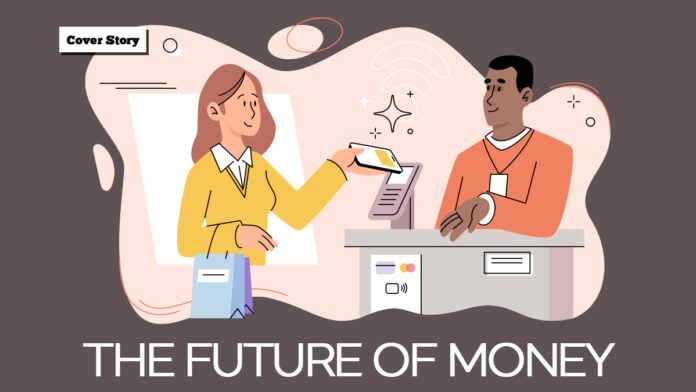Around five years ago, I tried an experiment. I went cashless for two months to see if I could survive using as little cash as possible and settling my payments through what was then a burgeoning e-wallet scene.
Little did I know that propelled by a paradigm-shifting pandemic, what was then an experiment has
become the new norm. The Visa Consumer Payment Attitudes study for 2023 showed that almost 55% of Filipinos use cashless payments. Based on the study, 43% of Filipino respondents carry less cash in their wallets. This marks a significant change in Filipinos’ attitude towards traditional cash payments.
Beyond the Philippines, cashless payments have taken off around the world. The Capgemini Research Institute’s 2023 World Payment Report found that noncash transactions reached 1.3
trillion. Statista forecasts that cashless transactions will increase to 2.297 trillion by 2027.

How the world is going cashless
Driving the global cashless trend are the new ways of transfering money. There are several methods for cashless payment. Globally, the largest and most common are credit and debit cards. Second, and rapidly becoming more popular, are QR payments through e-wallets/ mobile wallets. There
is also online banking and money transfer, NFC through e-wallets or mobile wallets, and finally, the fast-growing buy now pay later schemes.
The most recognizable and most common cashless payment method is payment utilizing your credit or debit card. Major retailers have been serving credit or debit users since the 1950s. They have been around for so long that they are considered a pillar in banking and financial services.
Also, an innovation for the cashless trend was the rise in digital banking. Online banking was an important result of the 1990s internet boom. It was a game changer in banking and finance, allowing depositors instant access to their accounts either through their smartphones or computers.
Digital or online banking allows users to seamlessly receive and send funds to other users not only in real-time but also securely. Online transactions completely remove the need to physically transfer cash from one account to another, as the bank’s own records would keep track of your transactions and balances.
E-wallets, sometimes called mobile wallets or digital wallets, are financial apps that store your financial information, and sometimes even your banking details. As the name implies, they
function like a wallet that users can place money digitally and then use these to pay for purchases or bills.
E-wallets burst onto the scene in 1998, when Paypal became the first mainstream e-wallet in the world. In 2003, a similar trend started in China, with Alibaba creating Alipay. Now, e-wallets dominate as the go-to digital payment solution.
There are two major ways how e-wallets complete a cashless transaction. First, there’s “tap-to-pay” which utilizes your device’s NFC and RFID to complete a secured connection and transaction. Tap-to-pay works beyond your mobile device, with the same technology being used in new credit and debit cards. The card’s EMV chips function like your phone’s NFC antenna, and data can be transferred through NFC and RFID.
The second major way is through QR codes. QR payments utilize your device’s camera to find and scan a specially generated QR code. Once scanned, the app recognizes the payment details encoded in the QR image and translates them into the app to complete the transaction. The only remaining step is authorizing the transaction through your chosen authentication method.

What is the future of cash?
There are a number of reasons why people are going cashless. Studies indicate that the major reasons are ease of use and accessibility. Cashless payments are faster than traditional payments. A simple tap or click, and you’re good to go.
It’s this reason why cashless adoption is rapidly rising. As many ditch the plain old dough, what’s
next? Just what is the future of money?
There have been several commentaries and studies on the topic.
Just before the pandemic, individuals heralded cryptocurrencies as the future of finance. Blockchain technology and crypto’s decentralized nature led many to believe that the future of money lies in a transparent and secure system.
One country actually accepts cryptocurrency as legal tender. El Salvador adopted Bitcoin as a recognized legal tender in 2021, which means that you can use Bitcoin like regular currency.
Unlike El Salvador, the world is not keen on jumping on the crypto train completely just yet. Many point out that the current crypto ecosystem is not conducive to making it a legitimate fiat currency replacement. The market remains volatile and unpredictable, two traits most governments don’t want for their economies.
Enter Stablecoins. Stablecoins are cryptocurrencies but, unlike traditional crypto, have a stable value. While regular cryptocurrency is highly dependent on supply and demand to determine its price, stablecoins are tied either to traditional fiat currency or a commodity.
The perfect example of stablecoins is the cryptocurrency Tether. Tether’s value is linked to the US Dollar, and the blockchain’s algorithm controls the supply to maintain stability and avoid fluctuations. Still, it’s not a foolproof system. In 2022, the stablecoin TerraUSD (UST) collapsed in what was essentially a crypto version of a bank run. A bank run is when depositors lose confidence in a bank and suddenly withdraw all their money. As banks move cash behind the scenes, a surge in withdrawals increases the chances of the bank defaulting, leading to more people losing their
savings.
Bank runs are rare in modern times as governments have placed certain safeguards and systems to prevent banks from immediately collapsing. This system includes insurance, bonds, and sometimes
necessary bailouts from the government to prevent a domino effect. Unlike a governmentbacked
currency, stablecoins lack the necessary infrastructure and system needed to prevent another
Terra from happening.
This leads us to central bank digital currencies, or CBDCs. CBDCs are digital currencies that, unlike cryptocurrencies, are wholly backed by a government and tied to its national banks and reserves. In a way, it’s similar to when banks print new cash, but instead of new paper money or coins, they assign the value to a digital token, achieving stability with the necessary infrastructure.
The main difference between a CBDC and a digital wallet/money is that the latter still has an equivalent cash amount tied to it. In essence, the 50 pesos in your e-wallet has a corresponding 50 pesos deposited in a bank. Depending on how central banks adopt CBDCs, these could be distinct from existing circulating money or could replace a portion of the circulating money.
Central Banks around the world have either adopted CBDCs or started testing them. Many, including the US, UK, and the Philippines, are still determining how to adopt CBDCs.
CBDCs are still relatively new, so there is still a sense of wait-and-see whether it could be the future
of money. For now, cash remains king in the foreseeable future. Through centuries of utilizing and trading with cash, it has become the bedrock of society. As we strive toward a digital financial future, for now, cash is still its foundation.
Words by Gabriel Pe
Also published in GADGETS Magazine September 2024 Issue.
